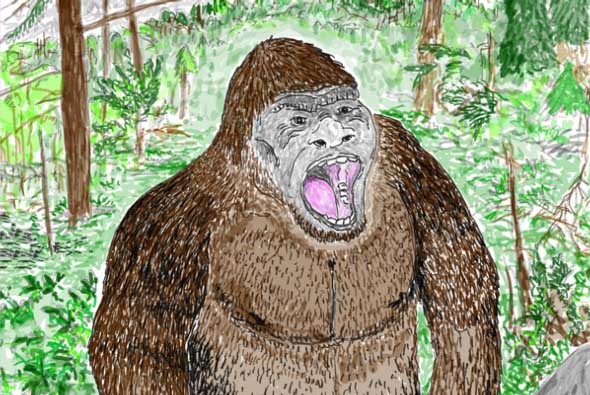
Bigfoot apparently does a lot of vocalising. This image is inspired by a particular scene you might recognise from the Animal Planet series Finding Bigfoot. Image by Darren Naish, CC BY.
June 28, 2016

Bigfoot apparently does a lot of vocalising. This image is inspired by a particular scene you might recognise from the Animal Planet series Finding Bigfoot. Image by Darren Naish, CC BY.
You will, I’m sure, have heard of the unconfirmed North American primate vernacularly termed Bigfoot or Sasquatch.
The cover of Naish (2016): the black figure with glowing eyes is especially relevant to this article.
I have a long-term, unshakeable interest in Bigfoot, and I’ve thought about the subject quite a lot, at least some of these thoughts having appeared here at Tet Zoo over the years. I do not think that the data we have at the moment – this includes tracks, hairs, vocalisations, photos, and the innumerable eyewitness accounts – provides support for the contention that Bigfoot is real, and have come to the conclusion that it is a sociocultural phenomenon: that people are seeing all manner of different things, combining it with ideas, memes and preconceptions they hold in their minds, and interpreting them as encounters with a monstrous, human-like biped. This contention is explored further in my recently-published book, Hunting Monsters (Naish 2016) (and, to prove that I have history, there’s also Naish (2012)).
And let me say, by the way, that I would love to be wrong… I still do hope that Bigfoot is real; that the version of the creature endorsed by Krantz (1999), Bindernagel (1998) and Meldrum (2006) is accurate and valid. But, alas.
Regular readers of Tet Zoo – and of certain of the things I’ve published (Conway et al. 2013, Naish 2014) – will be familiar with the idea that cryptozoology overlaps extensively with speculative zoology. Bigfoot might not be a genuine undiscovered primate species (so far as we can tell, right now)… but what if it was? In this article, and perhaps in one or two others that might appear in future, I’d like to play a game and ponder things pertaining to the Bigfoot evidence, such as it is. It is, after all, great fun to wonder what the existence of Bigfoot would mean for field biology and ecology in North America, for conservation and wildlife management, for our understanding of primate evolution and diversity, and for the relationship we have with the rest of the natural world. I’m not about to write about all of those hypotheticals right now, but, yes, they’re entertaining things to think about. In fact, I’d love to see some speculative fiction written along those lines… oh, to be fair, there is some stuff out there like that already: I’m only familiar with Lee Murphy’s books.
Incidentally, an interesting thing I’ve learnt about Bigfoot while writing this article (and others) is that there’s scarcely any Bigfoot imagery online which is marked for re-use: everything is protected by copyright and unavailable for free use by others. Make of that what you will. In the interests of making the world a better place, the pictures I created for this article are all released for use via a CC license.
Hunting Monsters: Cryptozoology and the Reality Behind the Myths
Biologically consistent, homogenous vocalisations would be documented across North America. Bigfoots purportedly make noises, and a standard part of modern Bigfoot lore is that people might be able to ‘call in’ or even communicate with Bigfoots by making wails, screams, roars or howls, or by hitting trees or rocks to make far-carrying percussive whacks, these sounds resembling the noises that are attributed to the creature. What’s notable is that these vocalisations are phenomenally diverse: the ‘Ohio howls’, ‘Samurai chatter’, the whoops, whistles, growls and howls attributed to this animal well exceed what we’d expect for a single animal species that communicates over long distances, and there’s nothing approaching homogeneity of the sort present across known primate species.
Indeed, some of the most incredible of these sounds – if you’ve never heard the ‘Sierra sounds’ or ‘Samurai chatter’ recorded by Ron Morehead, well, you’re in for a treat – sound nothing at all like the others that have been reported and recorded, and have only been heard exclusively in one small area. Even allowing for the possibility of regional and local dialects, of ontogenetic, annual or seasonal variation, or of this diversity being linked to a diversity of functional roles (close communication vs long-distance communication, mating calls vs parental vocalisations and so on), the noises and calls are absolutely all over the place and not in the least bit homogenous from one region to the next, as they should be if we’re dealing with an unknown primate species.
The conclusion must be that the noises have diverse origins, by which I mean that they are mostly sounds made by known animal species, including cattle, coyotes (and their hybrids) and humans. And, yes, I think that many of the more incredible Bigfoot sounds – ‘Sumarai chatter’ and other speech-like utterances among them – were generated by people.
Read the rest of Darren Naish’s article here.
About Craig Woolheater
Co-founder of Cryptomundo in 2005.
I have appeared in or contributed to the following TV programs, documentaries and films:
OLN's Mysterious Encounters: "Caddo Critter", Southern Fried Bigfoot, Travel Channel's Weird Travels: "Bigfoot", History Channel's MonsterQuest: "Swamp Stalker", The Wild Man of the Navidad, Destination America's Monsters and Mysteries in America: Texas Terror - Lake Worth Monster, Animal Planet's Finding Bigfoot: Return to Boggy Creek and Beast of the Bayou.
Filed under Bigfoot, Bigfoot Report, Books, Cryptozoologists, Cryptozoology, Evidence, Eyewitness Accounts, Folklore, Footprint Evidence, Pop Culture, Sasquatch, Skeptical Discussions